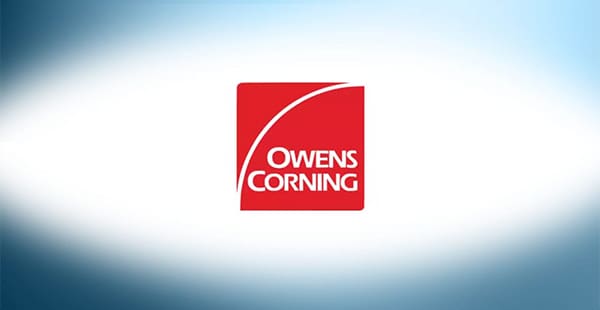Owens-Corning Fiberglas History of Asbestos Use
Owens-Corning Fiberglas Corporation was initially founded in 1938 in Toledo, Ohio, as a joint venture split between Corning Glass and Owens-Illinois. Corning Glass experimented with manufacturing glass fibers prior to this venture, but proposed the business idea to Owens-Illinois, as the company was also experienced in the glass industry. Together, they founded Owens-Corning Fiberglas in November of 1938 and reported sales of more than $2 million by year-end.
The earliest use of asbestos in Owens-Corning Fiberglas dates back to when they were founded. They used asbestos in yarn ties for fiberglass blankets, as well as in fiberglass blankets themselves. The most notable of Owens-Corning Fiberglas asbestos use was their Kaylo brand pipe covering and block insulation, which was sold from 1953 – 1973. Kaylo was used in commercial, residential and industrial insulation. Owens-Corning Fiberglas also manufactured asbestos-containing insulating cements sold in powdered form by the mid-1930s.
All of their products were popular and used widely, partially thanks to their marketing. Owens-Corning Fiberglas used the Pink Panther as a mascot to promote their famous pink insulation in the 1980s.
Because their insulation products were big sellers, the company changed its name to Owens Corning in 1996 to reflect their influence on industries beyond fiberglass, including cement and other building materials. Although the company had stopped manufacturing asbestos materials in the late 1970s, thousands of workers and consumers have been exposed to their asbestos-containing products, resulting in lawsuits against the company that are ongoing today.
Resources for Mesothelioma Patients
Owens Corning Asbestos Personal Injury Trust Fund
Owens Corning filed for Chapter 11 bankruptcy in 2000, as a result of multi-billion dollar asbestos liability claims. The Owens Corning/Fibreboard Corporation Asbestos Personal Injury Trust was established on October 31, 2006, and was initially funded with $5 billion to help settle asbestos claims. Included within this trust is the Owens Corning Asbestos Personal Injury Trust subfund, which began accepting claims on August 27, 2007. The subfund was initially funded with $3.42 billion.
Most Recent Information From Owens Corning Asbestos Personal Injury Trust
The trust’s year-end 2024 report revealed, as of December 31, 2024:
- Over 22,300 Owens Corning Asbestos Personal Injury Trust claims were paid.
- Over 26,600 unliquidated personal injury claims were received by the trust.
- Approximately $57 million was paid to asbestos victims by the Owens Corning asbestos trust.
- Over $3.073 million was reported in settled but unpaid claims.
- Approximately $484.65 million in total assets remain in the trust.
- The trust has received over 823,400 unliquidated claims since it was established.
- Approximately 448,300 Owens Corning asbestos trust claims have been paid since the inception of the trust.
- Approximately $3.11 billion in claim settlements has been paid to asbestos victims since the trust was established.
Current Owens Corning Asbestos Personal Injury Trust Payment Percentage
The current payment percentage is 4.7% for the Owens Corning Asbestos Personal Injury Trust. At a payment percentage of 4.7%, the current payout on an Owens Corning Expedited Review claim for mesothelioma is $10,105.
Determining Review Process When Filing an Owens Corning Asbestos Personal Injury Trust Claim
An experienced asbestos lawyer will evaluate the injured party’s information to determine the appropriate review process when submitting an Owens Corning asbestos trust claim. A sample of Owens Corning claims filed between 2022 and 2024 indicated that approximately 46% of claims were filed under the Expedited Review (ER) process. Approximately 68% of Owens Corning claims were filed using the Individual Review (IR) process.
- Expedited Review Process: Owens Corning claims meeting all medical and exposure criteria established in the Trust Distribution Procedures should be submitted through the ER process for a streamlined review. Eligible claims will receive the standard scheduled value based on the diagnosed disease level.
- Individual Review Process: Owens Corning claims submitted under the IR process undergo a detailed assessment of exposure, medical, and personal records to determine an individual liquidated value. This option is recommended for claimants diagnosed before age 70 who may qualify for higher payouts. IR filing is required for certain lung cancer cases, secondary exposure claims, or when standard trust criteria aren’t met.
The trust still accepts claims to compensate asbestos victims, with payments varying based on diagnosis, age, exposure history and the law firm’s settlement history. If you or a loved one had exposure to Owens Corning products and believe you are entitled to compensation, learn how a mesothelioma lawyer can help.
Owens-Corning Fiberglas Asbestos Products
Owens-Corning Fiberglas manufactured asbestos materials as early as 1938, with their most common products consisting of insulation, cement and other building materials. Despite other company and research knowledge of the risks of asbestos by this time period, Owens-Corning Fiberglas did not market their products as toxic, leaving many individuals at risk of dangerous exposure.
Owens-Corning Fiberglas and Occupational Exposure
Due to the presence of asbestos fibers in Owens-Corning Fiberglas products, many workers and consumers were exposed to hazardous fibers. With first-year sales amounting to $2.5 million and increased sales of more than $2 billion by the 1980s, thousands of factory workers mass-produced cement, insulation and other products, and millions of construction workers and individuals in other trades used the products.
Asbestos Litigation Against Owens-Corning Fiberglas
Owens-Corning Fiberglas and its new company name, Owens Corning, have faced thousands of lawsuits for their asbestos-containing products. The company neglected to market their asbestos products as hazardous, knowingly exposing their employees and consumers to the materials and causing asbestos-related diseases.
One notable case was a consolidation of asbestos exposure claims against Owens-Corning Fiberglas Corporation, which was settled in the District of Columbia Court of Appeals in 1997. The spouses of Paul D. Henkel, Hubert Stine and John Phares filed a lawsuit against Owens-Corning Fiberglas and other companies in 1992 for causing asbestosis or asbestos-related cancer from their asbestos materials.
The plaintiffs used the case of Dr. Kenneth Smith to defend their claims. The former medical director of Johns-Manville, another company that manufactured materials with asbestos, claimed that medical communities knew the risks of asbestos many years before exposing employees and Owens-Corning Fiberglas neglected to accurately convey those risks. The jury ultimately found Owens-Corning Fiberglas at fault for the asbestos injuries inflicted upon the plaintiffs. All three men died prior to the trial’s end, but their families were awarded a total of $13 million in damages.









